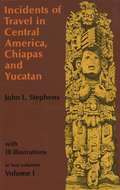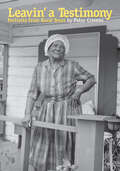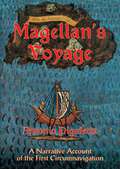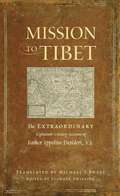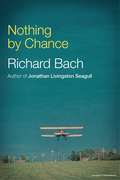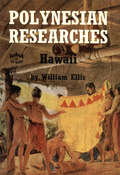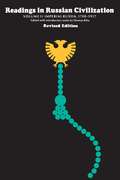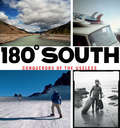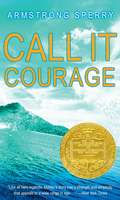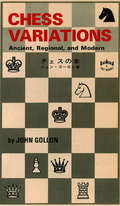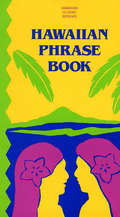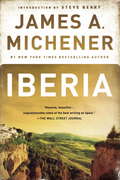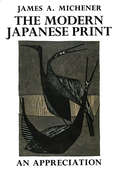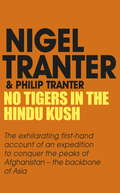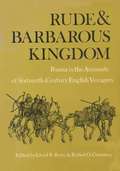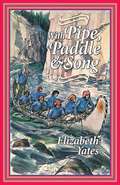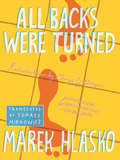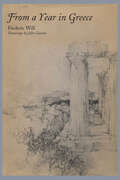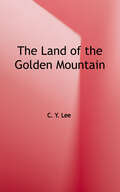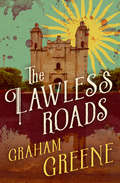- Table View
- List View
Incidents of Travel in Central America, Chiapas, and Yucatan, Volume I
by John L. StephensStephens' two expeditions to Mexico and Central America in 1839 and 1841 yielded the first solid information on the culture of the Maya Indians. The books in this two-volume set relate his archeological discoveries and exploration of ruined cities, monuments, and temples with penetrating and exciting narrative. Remarkably realistic illustrations by Frederick Catherwood double the appeal of the books.
Leavin' a Testimony: Portraits from Rural Texas (Focus on American History Series)
by Patsy CravensFirst settled by Stephen F. Austin's colonists in the early nineteenth century, Colorado County has deep roots in Texas history. Mainly rural and agrarian until late in the twentieth century, Colorado County was a cotton-growing region whose population was about evenly divided between blacks and whites. These life-long neighbors led separate and unequal lives, memories of which still linger today. To preserve those memories, Patsy Cravens began interviewing and photographing the older residents of Colorado County in the 1980s. In this book, she presents photographs and recollections of the last generation, black and white, who grew up in the era of Jim Crow segregation. The folks in Colorado County have engrossing stories to tell. They recall grinding poverty and rollicking fun in the Great Depression, losing crops and livestock to floods, working for the WPA, romances gone wrong and love gone right, dirty dancing, church and faith, sharecropping, quilting, raising children, racism and bigotry, and even the horrific lynching of two African American teenagers in 1935. The Colorado County residents' stories reveal an amazing resiliency and generosity of spirit, despite the hardships that have filled most of their lives. They also capture a rural way of life that was once common across the South, but is now gone forever.
Magellan's Voyage: A Narrative Account of the First Circumnavigation
by Antonio PigafettaRemarkable firsthand account by one of the few survivors of Magellan's epochal journey (1519-1522). Remarkably detailed record of new lands, flora and fauna, shipboard life, etc. Introduction. 28 halftones. Map.
Mission to Tibet
by Michael J Sweet Leonard Zwilling Fr. Ippolito Desideri S.J.Mission to Tibet recounts the fascinating eighteenth-century journey of the Jesuit priest ippolito Desideri (1684 - 1733) to the Tibetan plateau. The italian missionary was most notably the first european to learn about Buddhism directly with Tibetan schol ars and monks - and from a profound study of its primary texts. while there, Desideri was an eyewitness to some of the most tumultuous events in Tibet's history, of which he left us a vivid and dramatic account. Desideri explores key Buddhist concepts including emptiness and rebirth, together with their philosophical and ethical implications, with startling detail and sophistication. This book also includes an introduction situating the work in the context of Desideri's life and the intellectual and religious milieu of eighteenth-century Catholicism.
Nothing By Chance: A Gypsy Pilot's Adventures in Modern America
by Richard BachSetting out to explore his beliefs in the environment of a simpler time, Richard Bach shares the adventure of one magical summer he spent as an old-fashioned barnstormer flying an antique biplane. The journey is another soaring personal adventure of wonder and insight from the author of Jonathan Livingston Seagull.
Polynesian Researches: Hawaii
by William EllisPolynesian Researches:Hawaii is the famous record of the author's visit to the Hawaiian Islands in the early nineteenth century. <P><P>It includes an account of Hawaiian history, government, religion , warfare, and traditions- a general survey of Hawaiian life. More than this, it is the author's personal observations of Hawaiian manners and customs and is invaluable to anyone interested in old Hawaii.The author, Rev. William Ellis, lived in Polynesia as a missionary from 1817 to 1825. He spent much of his time in Tahiti and soon became fluent in the language. Before returning to England, he seized an opportunity to visit the Hawaiian Islands. He was soon able to talk with the natives in the Hawaiian language and made a tour of the island of Hawaii. On his tour he talked with chiefs, common people Hawaiian holy-men, and divinely possessed oracles. He climbed volcanoes, rode canoes, and visited the sight of Captain Cook's death. Besides the description of his tour, this book includes an account of Maui, Kahoolawe, Molokini, Lani, Molokai, Oahu, Kauai, Hiihau, and Kaula.The book is full of interesting descriptions of the author's encounters with Hawaiians. It is fast-moving and easy-reading. This book, an encyclopedic account of traditional Hawaii.
Readings in Russian Civilization Volume II: Imperial Russia, 1700–1917 (None Ser.)
by Thomas Riha"This new and enlarged version of Readings in Russian Civilization is the result of fairly extensive revisions. There are now 72 instead of 64 items; 20 of the selections are new. The first volume has undergone the least change with 3 new items, of which 2 appear in English for the first time. In the second volume there are 6 new items; all of them appear in English for the first time. The third volume has undergone the greatest revision, with 11 new items, of which 6 are newly translated from the Russian. It is the editor's hope that items left out in the new edition will not be sorely missed, and that the new selections will turn out to be useful and illuminating. The aim, throughout, has been to cover areas of knowledge and periods which had been neglected in the first edition, and to include topics which are important in the study of the Russian past and present. "The bibliographical headnotes have been enlarged, with the result that there are now approximately twice as many entries as in the old edition. New citations include not only works which have appeared since 1963, but also older books and articles which have come to the editor's attention."—From the Editor's Preface ". . . a judicious combination of seminal works and more recent commentaries that achieves the editor's purpose of stimulating curiosity and developing a point of view."—C. Bickford O'Brien, The Russian Review "These three volumes cover quite well the main periods of Russian civilization. The choice of the articles and other material is made by a competent and unbiased scholar."—Ivan A. Lopatin, Professor of Asian and Slavic Studies, University of Southern California
180° South
by Doug Tompkins Yvon Chouinard Jeff Johnson Chris Malloy180° South takes readers behind the scenes of the film, 180° South, made by Chris Malloy, to learn more about the people who made the original overland journey to Patagonia in 1968, and the repeat journey over ocean and land 40 years later. The book includes stories of events and experiences that inspired Chris Malloy, Yvon Chouinard, and Doug Tompkins to choose paths committed to saving what's left of the wild world. Open it anywhere and enjoy the photographs by the world's leading surf and climbing photographers Jeff Johnson, Jimmy Chin, Scotty Soen, and Danny Moder.
Call It Courage
by Armstrong SperryMaftu was afraid of the sea. It had taken his mother when he was a baby, and it seemed to him that the sea gods sought vengeance at having been cheated of Mafatu. So, though he was the son of the Great Chief of Hikueru, a race of Polynesians who worshipped courage, and he was named Stout Heart, he feared and avoided tha sea, till everyone branded him a coward. When he could no longer bear their taunts and jibes, he determined to conquer that fear or be conquered-- so he went off in his canoe, alone except for his little dog and pet albatross. A storm gave him his first challenge. Then days on a desert island found him resourceful beyond his own expectation. This is the story of how his courage grew and how he finally returned home. This is a legend. It happened many years ago, but even today the people of Hikueru sing this story and tell it over their evening fires.<P><P> Newbery Medal winner
Chess Variations
by John GollonChess Variations is a must for all chess enthusiasts and an outstanding book which promises many hours of pleasurable entertainment for all others. With more than 40 variations of the popular board game, this book contains, among others, the oldest known form of chess (Chaturanga), the game created by Edgar Rice Burroughs and introduced in his Martian series (Jetan), as well as regional forms currently played in Korea, Malaya, Burma, Thailand, and Japan.Also included in the book are charts, diagrams, and sample games played by the author and his friends.
Chess Variations
by John GollonLearn the many varieties of chess the world over with this concise chess guide.Chess Variations is a must for all chess enthusiasts and an outstanding book which promises many hours of pleasurable entertainment for all others. With more than 40 variations of the popular board game, this book contains, among others, the oldest known form of chess (Chaturanga), the game created by Edgar Rice Burroughs and introduced in his Martian series (Jetan), as well as regional forms currently played in Korea, Malaya, Burma, Thailand, and Japan.For those games that require boards or pieces other than those issued in playing modern chess, the author presents guidelines on "The Construction of Sets." Also included in the book are charts, diagrams, and sample games played by the author and his friends.The excitement of playing these exotic chess variations increases with the knowledge of their historic beginnings as well as with the movements of such strange-sounding pieces as the Zarafah, Ashwa, and Firzan.
Hawaiian Phrase Book
by Charles E. Tuttle Company, Inc.Originally, the primary object of this manual was to teach natives to converse in English. At the same time, the work is designed to assist strangers, speaking English, to acquire the correct colloquial speech of the Hawaiians.
Iberia
by James A. Michener"Massive, beautiful...Unquestionably some of the best writing on Spain...The best that Mr. Michener has ever done on any subject...Stunning...Memorable."THE WALL STREET JOURNAL Here, in the fresh, vivid prose that is James Michener's trademark, is the real Spain as he experiences it. He not only reveals the celebrated Spain of bullfights and warror kings, painters and processions, cathedrals and olive orchards; he also shares the intimate, often hidden Spain he has come to know, where toiling peasants and their honest food, the salt of the shores and the oranges of the inland fields, the congeniality of living souls and the dark weight of history conspire to create a wild, contradictory, passionately beautiful land, the mystery called Iberia.
The Littles Take A Trip
by John PetersonThe Little family takes a trip out from their house and into the woods and encounter many exciting and scary adventures.
The Modern Japanese Print: An Appreciation
by James A. MichenerThis is an ebook version of a very rare Japanese woodblock print collection. Originally published in 1962 in a limited edition of 475 copies, The Modern Japanese Print soon became a collector's item.<P><P>Included in the folio-sized volume were ten original woodblock prints by contemporary Japanese artists. The idea for this unique presentation had originated with author, James Michener who hoped to assist this little known group of dedicated men achieve wider recognition. The original works of art in The Modern Japanese Print were selected in a contest judged by art experts in the United States and Japan who sought to find the best examples representing " the richness and power of the modern Japanese print movement ."The ten original woodblock prints are reproduced in full color; Mr. Michener's text is retained completely. Aside from the artists whose works are shown, the author discusses many others who are contributing to the continuing development of this art form. James Michener's perceptive, informative introduction to modern Japanese printmaking, with commentary on each of the works, including full technical details, is written with critical acumen and notable prose.
No Tigers in the Hindu Kush
by Nigel Tranter Philip TranterPhilip Tranter and three friends drove a Land Rover 6,000 miles overland from Scotland to Nuristan to explore some of the unknown Central Hindu Kush area. They set out to attempt the second ascent of the monstrous Koh-i-Krebek; to ascend if possible at least one other major unclimbed mountain and to map that previously unmapped terrain. In fact, as well as Krebek they climbed nine other major peaks, named another dozen, and established the existence of a dramatic rock and ice range which they called the Rum Mountains, and christened individually after the Hebridean peaks they resembled in shape and beauty. The story of the expedition is told with an infectious enthusiasm for the glory and challenge of these mysterious peaks.
No Tigers in the Hindu Kush
by Nigel Tranter Philip TranterPhilip Tranter and three friends drove a Land Rover 6,000 miles overland from Scotland to Nuristan to explore some of the unknown Central Hindu Kush area. They set out to attempt the second ascent of the monstrous Koh-i-Krebek; to ascend if possible at least one other major unclimbed mountain and to map that previously unmapped terrain. In fact, as well as Krebek they climbed nine other major peaks, named another dozen, and established the existence of a dramatic rock and ice range which they called the Rum Mountains, and christened individually after the Hebridean peaks they resembled in shape and beauty. The story of the expedition is told with an infectious enthusiasm for the glory and challenge of these mysterious peaks.
Rude & Barbarous Kingdom
by Lloyd E. Berry Robert O. CrummeyLloyd E. Berry and Robert O. Crummey offer edited accounts of six English voyagers and their experiences in Muscovy Russia between 1553 and 1600. With modernized spelling and presentation, these accounts are accompanied by a glossary of Russian terms, introductions of their authors, and annotations that help put the travelers’ narratives into perspective.
With Pipe, Paddle and Song: A Story of the French-Canadian Voyageurs
by Elizabeth YatesSon of a French nobleman and a Chippewa Indian woman, Guillaume has spent half of his life in his father's Montréal château, half in his mother's village. When his father returns to France, the 16-year-old is determined to make his own way in the world. He signs up with a rough and ready crew of voyageurs, who yearly make their journey into the wilds of Canada to bring back the rich furs that have made New France prosperous. Newbery award winner Elizabeth Yates skillfully weaves history and the theme of a young man coming to grips with two worlds' conflicting demands. Included in the book is an extensive collection of voyageur songs, with music and lyrics.
All Backs Were Turned (Rebel Lit Ser.)
by Marek Hlasko Tomasz Mirkowicz"Hlasko was an original. His novels were fearless, his vision unsparing, and decades later, his darkly brilliant work has lost none of its power to unsettle. He achieved what few other writers ever have: he turned the literary landscape into a much more interesting place than it was when he found it." --Emily St. John Mandel, author of Station Eleven, Last Night in Montreal and The Singer's Gun"Blowtorch of a novel . . . matchless and prescient."-Publishers Weekly"Spokesman for those who were angry and beat . . . turbulent, temperamental, and tortured."-The New York Times"A self-taught writer with an uncanny gift for narrative and dialogue . . . a born rebel and troublemaker of immense charm."-Roman PolanskiIn this novel of breathtaking tension and sweltering love, two desperate friends on the edge of the law-one of them tough and gutsy, the other small and scared-travel to the southern Israeli city of Eilat to find work. There, Dov Ben Dov, the handsome native Israeli with a reputation for causing trouble, and Israel, his sidekick, stay with Ben Dov's recently married younger brother, Little Dov, who has enough trouble of his own. Local toughs are encroaching on Little Dov's business, and he enlists his older brother to drive them away. It doesn't help that a beautiful German widow named Ursula is rooming next door. What follows is a story of passion, deception, violence, and betrayal, all conveyed in hardboiled prose reminiscent of Dashiell Hammett and Raymond Chandler, with a cinematic style that would make Humphrey Bogart and Marlon Brando green with envy.Marek Hlasko, known as the James Dean of Eastern Europe, was exiled from Communist Poland and spent his life wandering the globe. He died in 1969 of an overdose of alcohol and sleeping pills in Wiesbaden, Germany.
From a Year in Greece
by Frederic WillIn this book, the reader is privileged to take a leisurely and thoroughly enjoyable trip through the Greece of the mid-twentieth century, led by a poet-narrator who is a comfortable and engaging guide and complemented by the artwork of John Guerin. Frederic Will recounts his odyssey: from Austria through Yugoslavia, across the northern Greek border, from Salonika to Athens and the Aegean Sea, to the site of remnants of Old Greece in Smyrna, Pergamum, and Ephesus, and finally to the monasteries on Mount Athos. The author not only presents vivid descriptions of the towns and people in contemporary Greece but also conveys the still-present aura of the ancient Greek deities, in both the ruins and the modern cities. Witness the following passage written at Salonika, in Northern Greece, Will’s first stop of importance: The sense-binding, sense-shaping ocean is omnipresent there. It is visible from nearly any point in the city. You only need to go up to your second story—if you have one. There is that pure, rhythmic, bounded but boundless element, spread somewhere at the bottom of the street. The same vision glimmers or stirs at the end of nearly every east-west-running street. Many townsmen spend much of their time promenading along the harbor. They seem to be subliminally magnetized to the sea. I spent several weeks there. During that time I would often go up to the crowning Venetian walls, and look down onto Salonika and its harbor. From there Salonika’s deep dependence on the ocean became a fact proved by eyesight. The city is built on the half-moon-shaped plain of the Axios River. Two images came to me repeatedly: that Salonika is an amphitheater facing the ocean; or that she is a lover, reaching to embrace the ocean. Here are the hot, white (or cream-colored) buildings of the city; there is the element they thirst for. Will gives a great deal of fascinating information but gives it gracefully and without excess. Above all, the narrative is suffused with the atmosphere, the emotions, and the beauty of Greece. The author has said he intends for this work to dramatize, not to instruct. Actually, it does both.
From a Year in Greece
by Frederic WillIn this book, the reader is privileged to take a leisurely and thoroughly enjoyable trip through the Greece of the mid-twentieth century, led by a poet-narrator who is a comfortable and engaging guide and complemented by the artwork of John Guerin. Frederic Will recounts his odyssey: from Austria through Yugoslavia, across the northern Greek border, from Salonika to Athens and the Aegean Sea, to the site of remnants of Old Greece in Smyrna, Pergamum, and Ephesus, and finally to the monasteries on Mount Athos. The author not only presents vivid descriptions of the towns and people in contemporary Greece but also conveys the still-present aura of the ancient Greek deities, in both the ruins and the modern cities. Witness the following passage written at Salonika, in Northern Greece, Will’s first stop of importance: The sense-binding, sense-shaping ocean is omnipresent there. It is visible from nearly any point in the city. You only need to go up to your second story—if you have one. There is that pure, rhythmic, bounded but boundless element, spread somewhere at the bottom of the street. The same vision glimmers or stirs at the end of nearly every east-west-running street. Many townsmen spend much of their time promenading along the harbor. They seem to be subliminally magnetized to the sea. I spent several weeks there. During that time I would often go up to the crowning Venetian walls, and look down onto Salonika and its harbor. From there Salonika’s deep dependence on the ocean became a fact proved by eyesight. The city is built on the half-moon-shaped plain of the Axios River. Two images came to me repeatedly: that Salonika is an amphitheater facing the ocean; or that she is a lover, reaching to embrace the ocean. Here are the hot, white (or cream-colored) buildings of the city; there is the element they thirst for. Will gives a great deal of fascinating information but gives it gracefully and without excess. Above all, the narrative is suffused with the atmosphere, the emotions, and the beauty of Greece. The author has said he intends for this work to dramatize, not to instruct. Actually, it does both.
A Glimpse of Eden
by Evelyn AmesA safari in East Africa brings a couple to see Africa with new eyes and gives them a greater appreciation of its wildlife and man's natural heritage.
The Land of The Golden Mountain
by C. Y. LeeSeeking a better life, losing everything, and yet finding a way to carry on. The trip across the Pacific to land was so strange and yet somewhat familiar. A story of family, loss, determination, friendship, travel, seafaring, and a gold rush. Learning to adjust and hold on to traditions. Disguising yourself to survive and yet yearning to show the world what beauty you possess.
The Lawless Roads: Journey Without Maps And The Lawless Roads (Penguin Twentieth Century Classics)
by Graham GreeneThis eyewitness account of religious and political persecution in 1930s Mexico inspired the British novelist’s “masterpiece,” The Power and the Glory (John Updike). In 1938, Graham Greene, a burgeoning convert to Roman Catholicism, was commissioned to expose the anticlerical purges in Mexico by President Plutarco Elías Calles. Churches had been destroyed, peasants held secret masses in their homes, religious icons were banned, and priests disappeared. Traveling under the growing clouds of fascism, Greene was anxious to see for himself the effect it had on the people—what he found was a combination of despair, resignation, and fierce resilience. Journeying through the rugged and remote terrain of Chiapas and Tabasco, Greene’s emotional, gut response to the landscape, the sights and sounds, the fears, the oppressive heat, and the state of mind under “the fiercest persecution of religion anywhere since the reign of Elizabeth” makes for a vivid and candid account, and stands alone as a “singularly beautiful travel book” (New Statesman). Hailed by William Golding as “the ultimate chronicler of twentieth-century man’s consciousness and anxiety,” Greene would draw on the experiences of The Lawless Roads for one of his greatest novels, The Power and the Glory.
